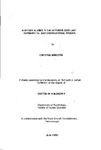AUDITORY ALARMS IN THE INTENSIVE CARE UNIT: EXPERIMENTAL AND OBSERVATIONAL STUDIES
| dc.contributor.author | MEREDITH, CHRISTINA | |
| dc.contributor.other | School of Psychology | en_US |
| dc.date.accessioned | 2013-10-22T08:41:42Z | |
| dc.date.available | 2013-10-22T08:41:42Z | |
| dc.date.issued | 1995 | |
| dc.identifier | NOT AVAILABLE | en_US |
| dc.identifier.uri | http://hdl.handle.net/10026.1/2264 | |
| dc.description.abstract |
There are many problems associated with the number of auditory warnings in hospital environments such as the Intensive Care Unit. As the amount of medical technology used to monitor a patient's condition increases, there is a concomitant increase in the number of auditory warnings. Each piece of equipment has its own alarm and often the sounds used are inappropriate. For example, the sounds are often too loud, too insistent and are irritating to staff, distracting them from other tasks. A further feature of sounds used for auditory alarms is that there is, at present, no agreement between manufacturers on the types of sounds used. This means that the same item of equipment can have different alarms if produced by different manufacturers. Subsequently there is the potential for confusion between alarms to occur if sounds are similar. The research presented in this thesis aims to investigate the psychological dimension of confusion between alarm sounds and the correct identification of a set of twelve auditory warnings currently in use in the I.C.U. Derriford Hospital, Plymouth. Hence, the first set of experiments examines the learning and retention of the set of auditory warnings in a laboratory setting. However, the many problems regarding auditory warnings should not be considered in isolation and in order to determine the types of activities undertaken by staff in the I.C.U. environment when alarms are activated, two observational studies were undertaken. The first study used a video camera and the second study involved direct observation using two observers. A series of tasks were developed that used the multiple resources literature as a framework and also represented tasks undertaken in the environment of the I.C.U. In the second experiment, participants were again required to learn and retain the set of auditory warnings. The tasks were introduced during the return stage of the experiment in order to examine first, whether there was an effect on the primary task of correctly identifying the sounds and whether the confusions between sounds increased or changed, and second to examine performance on the secondary tasks. The results showed that for all experiments in general participants required few trials to learn the sounds and the information was retained for a period of over one week. The results also showed that features of some sounds were easier to learn than other sounds and that certain sounds were consistently confused during each experiment. When the tasks were introduced performance on the primary task remained fairly constant, with no overall change or increase in the number of confusions between sounds. However, there was a decrement in the performance of the secondary tasks, as predicted by the dual-task literature. In conclusion, the results suggest that identification of sounds may depend on a global, overall label for a sound, such as a 'melodic' sound or a 'continuous' sound, with the more intricate details undetected by participants. The results also suggest that participants in the laboratory may alter their strategies to maintain performance on the primary task, by either responding more rapidly to task demands or by consciously deciding not to respond to one of the secondary tasks. | en_US |
| dc.description.sponsorship | Royal Aircraft Establishment, Farnborough | en_US |
| dc.language.iso | en | en_US |
| dc.publisher | University of Plymouth | en_US |
| dc.title | AUDITORY ALARMS IN THE INTENSIVE CARE UNIT: EXPERIMENTAL AND OBSERVATIONAL STUDIES | en_US |
| dc.type | Thesis | |
| dc.identifier.doi | http://dx.doi.org/10.24382/4419 | |
| dc.identifier.doi | http://dx.doi.org/10.24382/4419 |
Files in this item
This item appears in the following Collection(s)
-
01 Research Theses Main Collection
Research Theses Main


